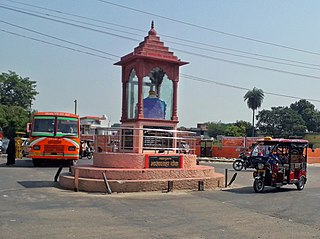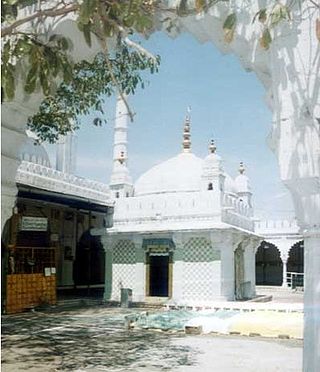
Sufism, also known as Tasawwuf, is a mystic body of religious practice found within Islam which is characterized by a focus on Islamic purification, spirituality, ritualism, asceticism, and esotericism. It has been variously defined as "Islamic mysticism", "the mystical expression of Islamic faith", "the inward dimension of Islam", "the phenomenon of mysticism within Islam", the "main manifestation and the most important and central crystallization" of mystical practice in Islam, and "the interiorization and intensification of Islamic faith and practice".

The Chishtī Order is a tariqa, an order or school within the mystic Sufi tradition of Sunni Islam. The Chishti Order is known for its emphasis on love, tolerance, and openness. It began with Abu Ishaq Shami in Chisht, circa 930 AD in a small town near Herat, a strategic city in then Eastern Persia, which later became independent and then part of Afghanistan.
Sultan-ul-Mashaikh, Mahbub-e-Ilahi, Sheikh Khwaja Syed Muhammad Nizamuddin Auliya, also known as Hazrat Nizamuddin, and Mahbub-e-Ilahi was an Indian Sunni Muslim scholar, Sufi saint of the Chishti Order, and is one of the most famous Sufis from the Indian Subcontinent. His predecessors were Fariduddin Ganjshakar, Qutbuddin Bakhtiyar Kaki, and Moinuddin Chishti, who were the masters of the Chishti spiritual chain or silsila in the Indian subcontinent.

A dargah is a shrine or tomb built over the grave of a revered religious figure, often a Sufi saint or dervish. Sufis often visit the shrine for ziyarat, a term associated with religious visitation and pilgrimages. Dargahs are often associated with Sufi eating and meeting rooms and hostels, called khanqah or hospices. They usually include a mosque, meeting rooms, Islamic religious schools (madrassas), residences for a teacher or caretaker, hospitals, and other buildings for community purposes.

Abū Yazīd Ṭayfūr bin ʿĪsā bin Surūshān al-Bisṭāmī (al-Basṭāmī), commonly known in the Iranian world as Bāyazīd Bisṭāmī, was a Persian Sufi from north-central Iran. Known to future Sufis as Sultān-ul-Ārifīn, Bisṭāmī is considered to be one of the expositors of the state of fanā, the notion of dying in mystical union with Allah. Bastami was famous for "the boldness of his expression of the mystic’s complete absorption into the mysticism." Many "ecstatic utterances" have been attributed to Bisṭāmī, which lead to him being known as the "drunken" or "ecstatic" school of Islamic mysticism. Such utterance may be argued as, Bisṭāmī died with mystical union and the deity is speaking through his tongue. Bisṭāmī also claimed to have ascended through the seven heavens in his dream. His journey, known as the Mi'raj of Bisṭāmī, is clearly patterned on the Mi'raj of the Islamic prophet Muhammad. Bisṭāmī is characterized in three different ways: a free thinking radical, a pious Sufi who is deeply concerned with following the sha'ria and engaging in "devotions beyond the obligatory," and a pious individual who is presented as having a dream similar to the Mi'raj of Muhammed. The Mi'raj of Bisṭāmī seems as if Bisṭāmī is going through a self journey; as he ascends through each heaven, Bisṭāmī is gaining knowledge in how he communicates with the angels and the number of angels he encounters increases.

Budaun is a medieval city and headquarters of Budaun district, Uttar Pradesh, India. It is located about a mile east of the Sot river, and 27 km north of the river Ganges, in the Rohilkhand region of Uttar Pradesh. According to the 2011 census, it has a total population of 159,221, which is projected at 161,555 at present. Budaun rose to historical importance as the capital of the Delhi Sultanate for four years from 1210 CE to 1214 CE during the reign of Sultan Iltutmish. It was the most important post of Northern Frontier during Mughal reign. Budaun is a big market, historically famous and religiously important city. Budaun is 230 km south-east of New Delhi and 245 km north-west of Lucknow, both taking about 6 hours by road.

Quṭb al-Aqṭāb Khwāja Sayyid Muḥammad Bakhtiyār al-Ḥusaynī, Quṭb al-Dīn Bakhtiyār Kākī was a Sunni Muslim Sufi mystic, saint and scholar of the Chishti Order from Delhi, India. He was the disciple and the spiritual successor of Mu'in al-Din Chishti as head of the Chishti order, and the person to whom the Qutb Minar, Delhi is dedicated. Before him the Chishti order in India was confined to Ajmer and Nagaur. He played a major role in establishing the order securely in Delhi. His dargah located adjacent to Zafar Mahal in Mehrauli, and the oldest dargah in Delhi, is also the venue of his annual Urs festivities. The Urs was held in high regard by many rulers of Delhi like Qutb ud-Din Aibak, Iltutmish who built a nearby stepwell, Gandhak ki Baoli for him, Sher Shah Suri who built a grand gateway, Bahadur Shah I who built the Moti Masjid mosque nearby and Farrukhsiyar who added a marble screen and a mosque.

Sufism is the mystical branch of Islam in which Muslims seek divine love and truth through direct personal experience of God. This mystic tradition within Islam developed in several stages of growth, emerging first in the form of early asceticism, based on the teachings of Hasan al-Basri, before entering the second stage of more classical mysticism of divine love, as promoted by al-Ghazali and Attar of Nishapur, and finally emerging in the institutionalized form of today's network of fraternal Sufi orders, based on Sufis such as Rumi and Yunus Emre. At its core, however, Sufism remains an individual mystic experience, and a Sufi can be characterized as one who seeks the annihilation of the ego in God.
Majnu Shah or Faqir Majnu Shah Burhan was a faqir from the present-day Uttar Pradesh, who actively participated in the Fakir-Sannyasi Rebellion, which, according to a number of scholars, was an early war for India's independence and joined in many battles against the British East India Company with his 'pious team'.

Nasiruddin Mahmud Chirag-Dehlavi was a 14th-century mystic-poet and a Sufi saint of the Chishti Order. He was a disciple of Sufi saint Nizamuddin Auliya, and later his successor. He was the last important Sufi of the Chishti Order from Delhi.

Sufism has a history in India evolving for over 1,000 years. The presence of Sufism has been a leading entity increasing the reaches of Islam throughout South Asia. Following the entrance of Islam in the early 8th century, Sufi mystic traditions became more visible during the 10th and 11th centuries of the Delhi Sultanate and after it to the rest of India. A conglomeration of four chronologically separate dynasties, the early Delhi Sultanate consisted of rulers from Turkic and Afghan lands. This Persian influence flooded South Asia with Islam, Sufi thought, syncretic values, literature, education, and entertainment that has created an enduring impact on the presence of Islam in India today. Sufi preachers, merchants and missionaries also settled in coastal Gujarat through maritime voyages and trade.
Araul is a town in Bilhaur city in Kanpur district in the state of Uttar Pradesh, India on G.T. Road and situated at bank of the holy river Ganga. It is 11 km from Town Bilhaur. Araul is located 62 km distance from its District Main City Kanpur and 15 km distance from Kannauj. It is located 92 km distance from capital of Uttar Pradesh (U.P.) Lucknow. Gangupur is nearest Semi Town (Village)
Makanpur is a town in Kanpur district in the state of Uttar Pradesh, India. Makanpur is a town in the tehsil of Bilhaur. Makanpur is well connected by rail and road. The nearest city to Makanpur is Araul, which is 4 km away.

Waris Ali Shah (1817–1905) was an Indian Sufi saint from Dewa, and the founder of the Warsi Sufi order. He traveled to many places specially Europe and the west and admitted people to his spiritual order. He belongs to the 26th generation of Hazrat Imam Hussain رضی اللہ عنہ His shrine is at Dewa, India.

Fatehpur District is one of the 75 districts of the Indian state of Uttar Pradesh. The district has a population of 2,632,733. Fatehpur city is its administrative headquarters.
The Golden Chain of Naqshbandi Haqqani Sufi Order is a lineage of Sufi masters of the Naqshbandi 'Aliyyah branch.

ʿAlā ul-Ḥaq wa ad-Dīn ʿUmar ibn As`ad al-Khālidī al-Bangālī, commonly known as Alaul Haq or reverentially by the sobriquet Ganj-e-Nābāt, was a 14th-century Islamic scholar of Bengal. Posted in Hazrat Pandua, he was the senior disciple and successor of Akhi Siraj, and a Bengal Sultanate government official.

Badīʿ al-Dīn, known as Shāh Madār, and by the title Qutb-ul-Madar 1315–1434), was a Syrian Sufi who migrated to India where he founded the Madariyya Sufi brotherhood. He is held in high esteem as a patron saint.

Ḥāfiẓ Aḥmad Jaunpūrī was an Indian Muslim scholar, religious preacher and social worker. As the son and successor of Karamat Ali Jaunpuri, he led the Taiyuni reformist movement in Bengal.












